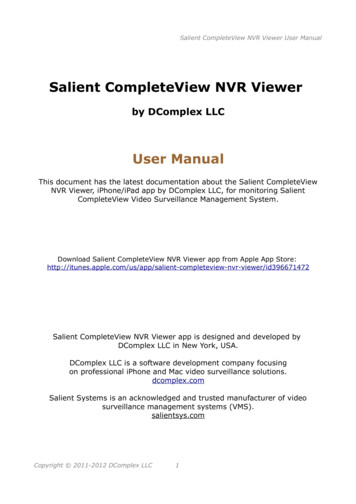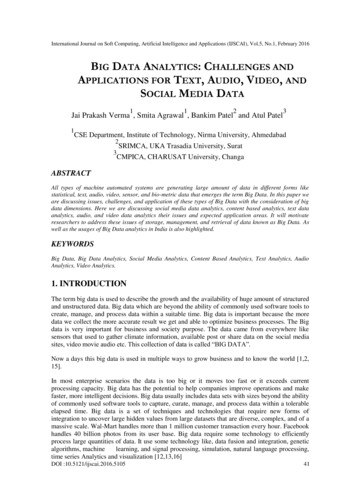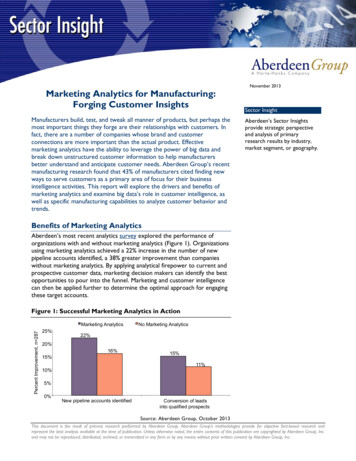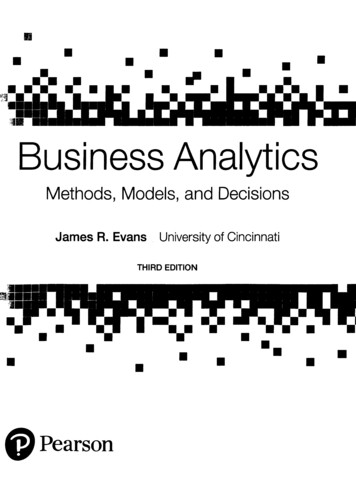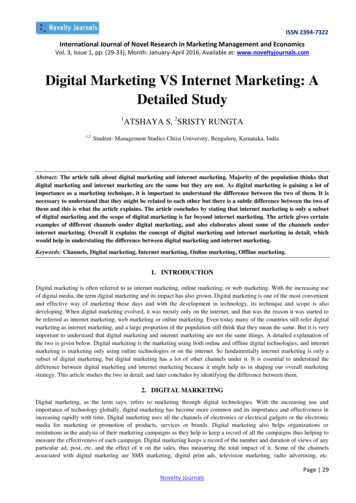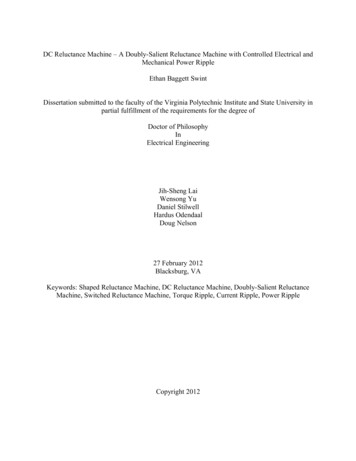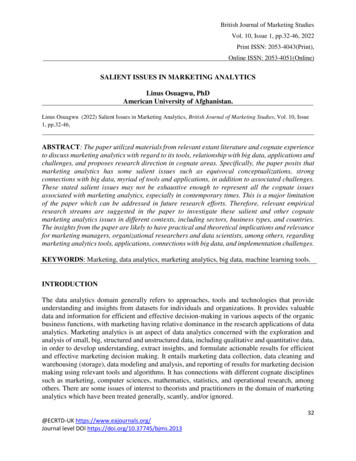
Transcription
British Journal of Marketing StudiesVol. 10, Issue 1, pp.32-46, 2022Print ISSN: 2053-4043(Print),Online ISSN: 2053-4051(Online)SALIENT ISSUES IN MARKETING ANALYTICSLinus Osuagwu, PhDAmerican University of Afghanistan.Linus Osuagwu (2022) Salient Issues in Marketing Analytics, British Journal of Marketing Studies, Vol. 10, Issue1, pp.32-46,ABSTRACT: The paper utilized materials from relevant extant literature and cognate experienceto discuss marketing analytics with regard to its tools, relationship with big data, applications andchallenges, and proposes research direction in cognate areas. Specifically, the paper posits thatmarketing analytics has some salient issues such as equivocal conceptualizations, strongconnections with big data, myriad of tools and applications, in addition to associated challenges.These stated salient issues may not be exhaustive enough to represent all the cognate issuesassociated with marketing analytics, especially in contemporary times. This is a major limitationof the paper which can be addressed in future research efforts. Therefore, relevant empiricalresearch streams are suggested in the paper to investigate these salient and other cognatemarketing analytics issues in different contexts, including sectors, business types, and countries.The insights from the paper are likely to have practical and theoretical implications and relevancefor marketing managers, organizational researchers and data scientists, among others, regardingmarketing analytics tools, applications, connections with big data, and implementation challenges.KEYWORDS: Marketing, data analytics, marketing analytics, big data, machine learning tools.INTRODUCTIONThe data analytics domain generally refers to approaches, tools and technologies that provideunderstanding and insights from datasets for individuals and organizations. It provides valuabledata and information for efficient and effective decision-making in various aspects of the organicbusiness functions, with marketing having relative dominance in the research applications of dataanalytics. Marketing analytics is an aspect of data analytics concerned with the exploration andanalysis of small, big, structured and unstructured data, including qualitative and quantitative data,in order to develop understanding, extract insights, and formulate actionable results for efficientand effective marketing decision making. It entails marketing data collection, data cleaning andwarehousing (storage), data modeling and analysis, and reporting of results for marketing decisionmaking using relevant tools and algorithms. It has connections with different cognate disciplinessuch as marketing, computer sciences, mathematics, statistics, and operational research, amongothers. There are some issues of interest to theorists and practitioners in the domain of marketinganalytics which have been treated generally, scantly, and/or ignored.32@ECRTD-UK https://www.eajournals.org/Journal level DOI https://doi.org/10.37745/bjms.2013
British Journal of Marketing StudiesVol. 10, Issue 1, pp.32-46, 2022Print ISSN: 2053-4043(Print),Online ISSN: 2053-4051(Online)Marketing is concerned with mutually-satisfying exchange transactions and relationships whichare purposed to lead to the achievement of marketing efficiency and effectiveness. Manyframeworks, including the marketing-mix framework and its revisions (Tukey, 1962; Winer &Neshin, 2014; Prohit et al., 2021), have been used to explain marketing issues. Also, many cognatedisciplines have contributed to the development of marketing theories and practices. One of suchdisciplines is data science. According to Turkey (1962), data science is concerned with proceduresfor collecting and analyzing data, techniques and tools for interpreting results from suchprocedures, ways of planning the gathering of data (in order to make the analysis of the data easier,more precise or accurate), and all the tools and technologies (statistical, mathematical, computer,etc.) which are used in analyzing the data.Marketing issues have been studied, over time, using sophisticated quantitative tools such asmathematical optimization, multivariate statistics, and econometrics, among others (Chintaguntaet al, 2016a). These quantitative tools have been used in such marketing areas as marketsegmentation, media mix optimization (maximization and/or minimization), data-based marketingplanning, consumer behavior research and decisions. These have resulted into marketing scienceand later marketing analytics. The evolution and revolution of marketing science in contemporarytimes has been a function of new and big data, new approaches to marketing analysis, and newpractices and insights, leading to developments in new models for marketing theory and practice.Generally, a model is a representation of key aspects or features of a phenomenon, thing or reality,and a good model needs to simplify and represent reality in order to be reasonably generalizable(Wedel and Kannan, 2016). However, no model represents the exact reality or phenomenoncorrectly and completely, although some models are useful (Box, 1976). Because of theavailability of different kinds of data (small/big, structured/unstructured), in addition to availabilityof greater computational and analytical tools, plus the need for organizational business managersto make decisions at different times, the need to build different types of business analytic modelsbecomes necessary, especially building business analytics models in the organic business functionsdifferent contextual settings, organizations and time periods.Marketing analytics models are aspects of business analytics models needed to provide insightsfor marketing management decisions in both profit and nonprofit organizations. Different types ofmarketing analytics models, including descriptive, diagnostic, predictive and prescriptivemarketing analytics models, are needed to produce and provide insights for efficient and effectivemarketing decisions. Generally, descriptive marketing analytics models deal with datasummarization and visualization; diagnostic marketing analytics models attempt to estimaterelationships between marketing variables, in addition to testing for hypotheses; predictivemarketing analytics models deal with forecast of marketing variables of interest, in addition tosimulation of marketing contexts; and prescriptive marketing analytics models deal withdetermination of optimal degrees of marketing variables (Wedel and Kannan, 2016).Marketing analytics, though important to various forms of organizations, has manyconceptualizations, which may affect its proper comprehension and applications. In addition, there33@ECRTD-UK https://www.eajournals.org/Journal level DOI https://doi.org/10.37745/bjms.2013
British Journal of Marketing StudiesVol. 10, Issue 1, pp.32-46, 2022Print ISSN: 2053-4043(Print),Online ISSN: 2053-4051(Online)are many tools that can be used to undertake marketing analytics activities. The tools to be usedfor marketing analytics in organizations will be a function of the purposes and contexts, in additionto organizational capabilities and associated challenges. This paper conceptualizes marketinganalytics, and isolates some of its salient issues such as relationship with big data, tools,applications and challenges. A discussion of marketing analytics with regard to these salient issuesof interest has the potential of providing relevant theoretical and practical insights, in addition tostimulating cognate areas for further research efforts.Conceptualizations of Marketing AnalyticsThere are forms of equivocations regarding marketing analytics conceptualizations. Marketinganalytics can be conceptualized as the scientific process of transforming data into information andinsights for making better marketing decisions. It is the application of scientific, mathematical,computer and marketing knowledge and methods to the study and analysis of marketing problemsinvolving complex systems or relationships and variables. It is a branch of business analyticsfocusing on the collection, management and analysis of relevant data to aid marketing decisions(Hanssens and Pauwels, 2016; McKinsey, 2016). In marketing analytics, data, people, processes,technologies and tools are systematically integrated to generate relevant knowledge andunderstanding for marketing theories and decisions. Organizations and professionals specializingin marketing analytics produce knowledge in functional marketing issues, measure the lifetimevalues of customers and clients, and help to generate insights for improving relevant measures ofmarketing performance (Branda et al., 2018).Marketing analytics can also be conceptualized as the sourcing, management, and analysis (usingdescriptive, causal, diagnostic, predictive and prescriptive tools and approaches) of marketing datain order to provide knowledge and understanding regarding marketing practices, strategies,environments and efficiency and effectiveness. It deals with the connections among data(structured and unstructured), relevant technologies and marketing decisions with the purpose ofproviding insights for achieving efficient and effective decisions in specific marketing contexts. Ithas benefited from contributions from other cognate disciplines such as computer science,statistics, mathematics, marketing, business management, economics, econometrics, psychology,engineering, operations research, and psychometrics and data science. Therefore, its domaincomprises many departments and disciplines, and has an elastic content (Krishen and Petrescu,2017). In addition, marketing analytics has benefited from the introduction of the World WideWeb in 1995 (Wedel and Kannan, 2016). This is mainly because of the interconnectedness, viainformation communications technologies, of the entities (customers, clients and marketinganalysts and decision makers) that generate and utilize relevant big data. Generally, in themarketing domain, there are interconnections among marketing research, strategic marketing andmarketing analytics. Marketing analytics has connections with marketing, decision sciences,operations management, finance, economics, management information system (MIS), and generalmanagement (Krishen and Petrescu, 2018), and is an attractive career in the 21st century(Davenport and Patil, 2012). Marketing analytics can be tactical, strategic and time-dependent34@ECRTD-UK https://www.eajournals.org/Journal level DOI https://doi.org/10.37745/bjms.2013
British Journal of Marketing StudiesVol. 10, Issue 1, pp.32-46, 2022Print ISSN: 2053-4043(Print),Online ISSN: 2053-4051(Online)depending on the decision issues being supported, in addition to the type of data and purpose ofthe analysis (Miles, 2014).With regard to process, marketing analytics has been conceptualized involve the observation andcollection of data about marketing issues and situations, generation of models to represent themarketing issues and situations, and the assessment of marketing policies and strategies, includingtheir relevant impacts, using relevant approaches, technologies and tools (Wedel and Kannan,2016). The steps in the marketing analytics process are iterative (i.e. backward and forward), whereeach step benefits from other steps in the process. Generally, the marketing analytics processinvolves isolating relevant marketing metrics, analyzing the marketing metrics, designing andimplementing relevant marketing analytics actions, in addition to evaluating relevant marketingactions based on insights from marketing analytics. Relevant tools are used to undertake the stepsand activities in the marketing analytics process.Presented in figure 1.0 are some of the salient issues of interest in marketing analytics. Discussionof these issues follows.Marketing analyticstoolsMarketinganalytics & bigdataMARKETING ANALYTICSMarketinganalyticsapplicationsMarketing analyticschallengesFigure 1.0: Some salient issues in marketing analytics.Marketing Analytics and Big DataIn contemporary times, huge amounts of data are emanating from many and different sources (Kuoand Kusiak, 2019). About 59 % of world population (which is about 4.54 billion persons) use theinternet system (Statista, 2020) and provide huge amounts of data for marketing activities. Thesehuge amounts of data are referred to as big data, and possess such peculiarities that traditionalsoftware technologies and tools are unable to collect, warehouse, process and analyze (Mayinkaet al., 2011). Also, big data emanate from sensors, digitizers, scanners, numerical modeling, mobile35@ECRTD-UK https://www.eajournals.org/Journal level DOI https://doi.org/10.37745/bjms.2013
British Journal of Marketing StudiesVol. 10, Issue 1, pp.32-46, 2022Print ISSN: 2053-4043(Print),Online ISSN: 2053-4051(Online)phones, the internet system, videos, audios and social media networks, among others (Yang et al.,2017). In addition, big data emanate from many and different sources, and can be structured andunstructured, including databases of big companies, mobile apps data, web analytics data, socialmedia data, and internet of things (IoT) data, among others (France and Ghose, 2019).Big data may be defined as data that is too big or too complex to be processed on a single machineor by traditional analysis, approaches, techniques and tools. They are data whose scale, distributiondiversity and velocity require the use of technical architecture, analytics and tools in order toprovide insights that reveal hidden knowledge and pattern and create value for decision-making.It is a brand of capital used by an organization to achieve its goals and objectives (MayerSchönberger and Cukier, 2013; Erevelles et al., 2016). Generally, big data is characterized byvolume, variety, velocity, value, visualization, variability and veracity/accuracy, and thesepeculiarities have important implications from the perspectives of computing, marketing andanalytics (Wedel and Kannan, 2016). Big data include numerical data, text, audio, and video fileswhich are increasingly interrelated, and marketing analytics will benefit from big data byintegrating knowledge from cognate disciplines such as data science, machine learning, textprocessing, audio-processing, and video-processing (Chintagunta et al, 2016b), including theirrelevant tools, techniques and methods.Big data for marketing analytics include data from competitor analysis, customeranalysis/customer profiling, segmentation analysis, demographic analysis, and marketingpersonnel skills analysis, among others. Big data for marketing analytics are also generated by bigorganizations such as Walmart, Tesco, Amazon, Konga, Jumia, Airtel, MTN, Apple, Visa, Netflix,Google, Facebook, and OK Cupid, among many others. These organizations utilize different formsof marketing analytics tools and approaches for market segmentation, consumer behavior dataanalysis, and marketing-mix decisions, among others. Therefore, in contemporary marketingenvironment, marketers need to collect, warehouse, analyze and deploy big data in order to makeefficient and effective marketing decisions (Grandhi et al., 2020).Big data, information and knowledge generated from relevant marketing activities can bemeaningfully connected via marketing analytics (Krishen and Petrescu, 2018b). Generally,organizational marketers study the behaviours of their customers and clients (including their needsand wants), design appropriate goods and services to address the needs and wants, andcommunicate relevant information about the goods and services to the customers and clients(Kang, 2018). Marketers use digital and social media platforms, among others, to generate big dataand undertake their marketing activities in order to achieve their marketing objectives efficiently(Ajina, 2019), in addition to altering consumer and client behaviours (Alam et al., 2019). Theseplatforms generate big data for marketing activities, and marketing analytics technologies and toolsprovide useful understanding and knowledge from the generated big data for efficient and effectivemarketing decisions (Cao et al, 2019).36@ECRTD-UK https://www.eajournals.org/Journal level DOI https://doi.org/10.37745/bjms.2013
British Journal of Marketing StudiesVol. 10, Issue 1, pp.32-46, 2022Print ISSN: 2053-4043(Print),Online ISSN: 2053-4051(Online)In contemporary marketing decisions, big data analytics technologies and tools attempt to drawrelevant marketing patterns, inferences and predictions regarding the tendencies of entities,including marketers, customers and clients (Wachter and Mittelstadt, 2019). Via big data analyticstechnologies and tools, marketers can study customers and clients, target their needs and wants,and serve them efficiently and effectively with appropriate goods and services. In addition, bigdata analytics technologies are associated with new information practices in the organization,creation of new organizational marketing management decision-making possibilities, andsupporting of organizational innovation processes (Niebel et al., 2019), including innovation inmarketing practices and processes. However, there are challenges associated with the utilizationof marketing analytics in big data (Johnson et al., 2019).Marketing Analytics ToolsTechnological advancements and their associated tools in marketing analytics are altering manydimensions of marketing activities, including customer experience (Flavian et al., 2019).Marketing analytics tools constitute some of the technological tools used by organizations incontemporary times to expose hidden insights (Erevelles et al., 2016; Krishen and Petrescu, 2017).Generally, the landscape of marketing theory and practice has been altered in recent years viasocial media, digital marketing, big data, and marketing analytics (Moorman, 2016; Verhoef et al,2016; Iacobucci et al., 2019). In addition, marketing analytics research has been a topical area ofinterest for some years (Wang and Wang, 2020), and the trends in marketing analytics involvemovement from big data (BD) to machine learning (ML), and then to artificial intelligence (AI),including use of robotics in services marketing (Belanche et al., 2020). These trends are impactingon many aspects of organizational marketing activities.Therefore, marketing analytics is associated with the exploration and quantitative analysis of allavailable structured and unstructured data, including qualitative and quantitative data, usingrelevant tools, in order to develop understanding, extract knowledge, and formulate actionableresults for marketing decision making. Such data include numerical, textual, audio, and video data,among others. It entails data collection, data cleaning and warehousing (storage), data modelingand analysis, and reporting of results for marketing decision making using relevant technologiesand tools. It deals with the use of tools and data (quantitative and qualitative) to answer marketingquestions. Using relevant tools, it is an organizational marketing management orientation whichcan be conceptualized, operationalized, contextualized and tested for the determination ofperformance impacts (Branda et al., 2018). However, Krishen and Petrescu (2018a) caution thatmarketing analytics is useless without relevant supporting theories and explanations.There has been increased interest in marketing analytics over the years (Petrescu and Krishen,2017). Marketing analytics is a multidisciplinary and inclusive domain that provides data-basedinsights, using relevant technologies and tools, for marketing theories and practices, including acombination of technologies and tools. Marketing analytics technologies and tools are baseplatforms and software systems that assist marketers with relevant insights to make evidence-basedmarketing decisions. They measure marketing activities and provide knowledge and understanding37@ECRTD-UK https://www.eajournals.org/Journal level DOI https://doi.org/10.37745/bjms.2013
British Journal of Marketing StudiesVol. 10, Issue 1, pp.32-46, 2022Print ISSN: 2053-4043(Print),Online ISSN: 2053-4051(Online)for making efficient and effective marketing decisions. There are many technologies and tools formarketing analytics, and these technologies and tools can be used for tactical or strategic marketingdecision purposes. The marketing analytics purpose, in addition to available human and nonhuman resources in the organization, will guide the choice of the marketing analytics technologiesand tools.According to Davenport et al (2019), artificial intelligence (AI) and allied tools and technologies,including machine learning technologies and tools, have the potential of altering marketingtheories and strategies, in general, and consumer and client behaviours, in particular. Marketinganalytics technologies and tools are generally used for visualization, segmentation and classprediction purposes (France and Ghose, 2019). Some of the tools and technologies for marketinganalytics include R, Hadoop, Machine learning, Apache Spark, SPSS, ClickView, Splink (an easypayment platform for customers and clients), Statistical models, Microsoft Excel, Python andMicrosoft Azure Studio, among others, in addition to evolving contemporary marketing analyticstechnologies and tools (Usha, 2000b).Marketing Analytics ApplicationsThe adoption and application of any form of technological tool, including marketing analytics tool,can be explained using some relevant models such as the unified theory of acceptance and use oftechnology (UTAUT) and the technology-organization-environment (TOE) models, among others((Venkatesh et al., 2003; Alshamaila et al., 2013; Effendi et al., 2020). Marketing analytics hasbecome an important technological tool portfolio for organizational marketing decision-makers asa result of advances in technology (Hauser, 2007). According to Chui et al (2018), marketing andsales are the major organic business functions with the greatest application potentials for marketinganalytics, including artificial intelligence (AI) and allied technologies and tools. AI tools andtechnologies can be used to analyze data for marketing decisions (Davenport et al, 2019).Generally, there are many applications of data analytics in marketing (IDG, 2016), includingcustomer behaviour analytics and customer relations management (Mile, 2014). It also hasapplications in other functional areas of marketing management (such as pricing, productmanagement issues, distribution channel decisions, and marketing promotions, among others), inaddition to assessment of marketing environment and performance measurement issues. Marketingperformance measures are enhanced via the use of marketing analytics (Cao and Tian, 2020).Generally, marketing analytics can be utilized in many aspects of marketing activities such asretailing, marketing performance assessment, general marketing management decisions, andcustomer analytics, among others (Iacobucci et al., 2019). Marketing analytics can also be appliedto customer/client generation, prediction of consumer/client behavior, market segmentation,digital marketing, interactive marketing, and marketing promotions, among others (Usha, 2020a).In addition, the marketing mix elements of product and promotion are major marketingmanagement issues in marketing analytics (France and Ghose, 2019). Also, there are marketinganalytics applications for optimizing marketing-mix expenditure, personalization of marketingmix elements to individual customers and clients, relationship management of customers and38@ECRTD-UK https://www.eajournals.org/Journal level DOI https://doi.org/10.37745/bjms.2013
British Journal of Marketing StudiesVol. 10, Issue 1, pp.32-46, 2022Print ISSN: 2053-4043(Print),Online ISSN: 2053-4051(Online)clients, privacy and security of customers and clients (Wedel and Kannan, 2016), and productinnovations and brand protection against uncertainties (Johnson et al., 2019).Customer/client analytics is a major dimension of marketing analytics, which connects big datawith consumer and client behaviour issues (Erevelles et al., 2016). It deals with the collection ofdata, management of data, analysis of data, and strategic use of an organization’s data onconsumers’ and clients’ behaviours toward its goods and services. Customer analyticstechnologies and tools help marketing decisions makers to make sense of mass data fromcustomers and clients (Sathyanarayanan, 2010), and help in bridging any knowledge gap relatingto customers and clients (Chaston, 2015). In addition, customer analytics can be applied in theprediction of the behaviours of customers and clients, segmentation of customers and clients,analysis of the needs and wants of customers and clients, and analysis of the life-time values ofcustomers and clients (Bailey et al., 2009). Customer analytics can also be used to analyzedeterminants of the behaviours of customers and clients towards goods and services, in addition tothe impacts of marketing variables on the buying decision processes of customers and clients.Some other marketing areas for the application of marketing analytics include branding strategy,customer acquisition, customer insight, customer retention, digital marketing, productdevelopment, product positioning and promotional strategy (CMO, 2016). In addition, marketinganalytics helps marketers to access and relate with their customers and clients efficiently andeffectively (Cvitanovic, 2018). According to Petrescu and Krishen (2017), marketing analytics hasrelevance in customer analytics, big data mining and text mining, social network analytics ofcustomers and clients, market forecasting, and customers’ relationship management activities,among others. In addition, marketing analytics can be used for curation of product brand images,identification of specific sales promotion target segments, personalization incentives fororganizational customers and clients, and identification of electronic word of mouth (eWOM)marketing communications (Vermeer et al., 2019). Also, marketing analytics has beneficialapplications in marketing decisions relating to product development, advertising, distribution,retailing, marketing research and intelligence (Hair, 2007). Alijumah et al (2021) posit, withempirical evidence, that the success of new product development is partly a function of properutilization of marketing analytics. However, Xavier et al (2011) argue that marketing analyticsapplications are ambiguous.Marketing Analytics Challenges.Marketing analytics practices, technologies and tools, generally, are associated with challengesand opportunities. Krishen and Petrescu (2018) lament that the equivocation in theconceptualizations and scope of marketing analytics has created challenges for relevant theorists,researchers and practitioners. Also, Metz (2018) posits that some data analytics technologies andtools, including artificial intelligence technologies and tools, are generally problematic. Some ofthe challenges confronting data analytics technologies and tools relate to data privacy, biases insoftware algorithms and ethical considerations (Larson, 2019). According to IDG (2016), themajor challenges confronting marketing analytics include finding relationships among different39@ECRTD-UK https://www.eajournals.org/Journal level DOI https://doi.org/10.37745/bjms.2013
British Journal of Marketing StudiesVol. 10, Issue 1, pp.32-46, 2022Print ISSN: 2053-4043(Print),Online ISSN: 2053-4051(Online)sources of data, estimating or predicting sales of goods or services, and predicting customer orclient behaviour, among others. Also, the privacy concerns of customers and clients constitutesome of the challenges associated with marketing analytics. In addition, big data issues relating todata outliers and impurities can pollute marketing analytics activities, and impact negatively onassociated marketing decisions.Some other challenges associated with marketing analytics in an organization relate to lack ofrelevant organizational direction with regard to marketing analytics, lack of organizationalpersonnel with requisite skills and expertise, lack of appropriate marketing analytics technologiesand tools, and lack of supportive organizational culture for marketing analytics practices andstrategies. In addition, there are challenges relating to the integration of various forms of data formarketing analytics and decisions (Hanssens and Pauwels, 2016; Iacobucci et al., 2019), analysisof data generally (Verhoef et al., 2016), and lack of validated measurement scales for theassessment of marketing analytics applications and tools in organizations. Also, many marketingorganizations seem not to have adequate knowledge, understanding and utilization ofcontemporary marketing analytics tools and technologies (Duan et al., 2019; Miklosik et al., 2019).In addition, although data analytics tools ( which include predictive analytics, data mininganalytics, case-based reasoning analytics, exploratory data analytics, business intelligenceanalytics, and machine learning tools, among others) exist (Tan et al., 2017), Wong (2012) lamentsthat data analytics tools to handle unstructured big data seem to be lacking or inadequate. Inaddition, there is lack of adequate marketing analytics tools and technologies for marketingdecision-makers, researchers and practitioners to benefit from the huge potentials of big data (Tanand Zhan, 2017), especially in developing economies and among small business enterprises(SMEs). Also, big data marketing analytics is associated with some challenges relating to mining,storage, transportation, and processing (Yang et al., 2017), in addition to lack of organizationalcapabilities required for the utilization of marketing analytics for marketing activities (Rahman etal., 2021), including social media analytics capability for marketing decisions (Wang et al., 2020).However, some of these challenges are s
in marketing analytics produce knowledge in functional marketing issues, measure the lifetime values of customers and clients, and help to generate insights for improving relevant measures of marketing performance (Branda et al., 2018). Marketing analytics can also be conceptualized as the sourcing, management, and analysis (using
